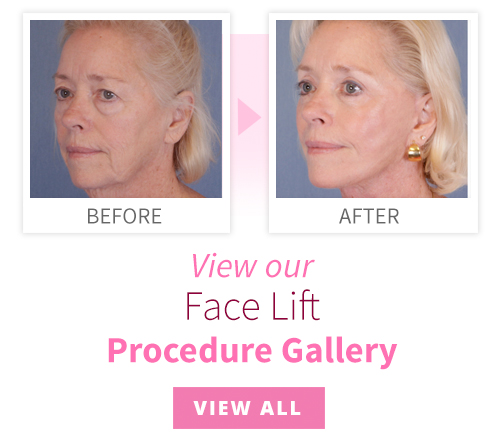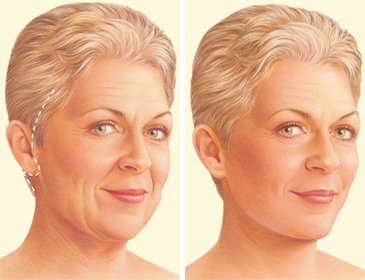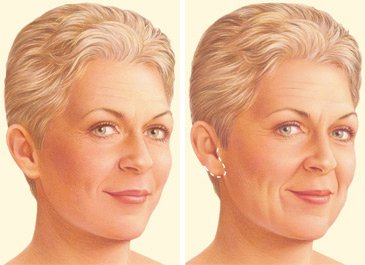Age, talking, laughing, years of sun exposure, etc. take a toll on your face. These cause lax skin, creases, drooping, and wrinkles making you look tired and also give a negative appearance of anger and worry. The plastic surgeon will evaluate your skin, muscles, and bone structure of your face as well as your general health to determine the appropriate treatment options. He will also consider your concerns and choose or suggest various other procedures.
The face lift addresses the mid-portion of the face, jowls, and neck. It tightens the muscles and removes the excess skin based on the tightened muscles. Ancillary procedures may be suggested and indicated to achieve a smooth transition from one area to the other. Procedures like skin resurfacing, fillers, Botox, and facial implants will further the result.
The best way to tell whether a face lift will help you is by consultation with your plastic surgeon and discussing with him your personal goals with regards to your facial appearance.
Procedure Details: Face Lift
Procedure: Improving sagging facial skin, jowls, and loose neck skin by removing excess fat, tightening muscles, redraping skin. Most often done on men and women over 40.
Length: Several hours.
Anesthesia: Local with sedation, or general.
In/Outpatient: Usually outpatient. Some patients may require short inpatient stay.
Side Effects: Temporary bruising, swelling, numbness and tenderness of skin; tight feeling, dry skin. For men, permanent need to shave behind ears, where beard-growing skin is repositioned.
Recovery:
- Back to work: 10 to 14 days.
- More strenuous activity: 2 weeks or more.
- Bruising: 2 to 3 weeks. Must limit exposure to sun for several months.
Duration of Results: Usually 5 to 10 years.
Questions & Answers
What is a facelift?
A facelift, or rhytidectomy, is a surgical procedure that improves visible signs of aging in the face and neck, such as:
- Sagging in the middle of your face
- Deep creases below the lower eyelids
- Deep creases along the nose extending to the corner of the mouth
- Fat that has fallen or has disappeared
- Loss of skin tone in the lower face that creates jowls
- Loose skin and excess fatty deposits under the chin and jaw can give even a person of normal weight the appearance of a double chin
The loss of youthful contours in the face can be due to a variety of factors, including heredity, gravity, environmental conditions, and stress.
Rejuvenation procedures typically performed in conjunction with a facelift are brow lift, to correct a sagging or deeply furrowed brow, and eyelid surgery to rejuvenate aging eyes.
What a facelift won’t do
As a restorative surgery, a facelift does not change your fundamental appearance and cannot stop the aging process.
A facelift can only be performed surgically; non-surgical rejuvenation treatments cannot achieve the same results, but may help delay the time at which a facelift becomes appropriate and complement the results of surgery.
Facelift cost
Your cost will be based on your individual plan and procedure.
Call us at (352) 629-8154 to set up a FREE Consultation.
We offer patient financing plans, so be sure to ask.
The cost of facelift surgery may include:
- Surgeon’s fee
- Hospital or surgical facility costs
- Anesthesia fees
- Prescriptions for medication
- Post-surgery garments, and
- Medical tests
When choosing a board-certified plastic surgeon for facelift surgery, remember that the surgeon’s experience and your comfort with him or her are just as important as the final cost of the surgery.
Facelift candidates
In general, good candidates for a facelift include:
- Healthy individuals who do not have medical conditions that impair healing
- Non-smokers
- Individuals with a positive outlook and realistic expectations
Facelift recovery
During your facelift recovery, a bandage might be placed around your face to minimize swelling and bruising once your procedure is completed.
Thin tubes may be present to drain any excess blood or fluid that may collect under the skin.
You will be given specific instructions that may include how to care for the surgical site and drains, medications to apply or take orally to aid healing and reduce the potential for infection, specific concerns to look for at the surgical site or in your general health, and when to follow up with your plastic surgeon.
Be sure to ask your plastic surgeon specific questions about what you can expect during your individual recovery period.
- Where will I be taken after my surgery is complete?
- What medication will I be given or prescribed after surgery?
- Will I have dressings/bandages after surgery?
- When will they be removed?
- Are stitches removed? When?
- When can I wear make-up?
- When can I resume normal activity and exercise?
- When can I see my stylist for hair color and cut?
Facelift before and after results
It may take a few months for swelling to fully dissipate and for incision lines to mature.
Facelift Before & After Photos
Life-long sun protection and a healthy lifestyle will help extend the results of your rejuvenated, more youthful appearance.
As swelling and bruising subside, the visible improvements of a facelift appear. Your final result should not only provide a more youthful and rested appearance, but also help you feel more confident about yourself.
Although good results are expected from your procedure, there is no guarantee. In some situations, it may not be possible to achieve optimal results with a single surgical procedure and another surgery may be necessary.
Following your physician’s instructions is essential to the success of your surgery.
It is important that the surgical incisions are not subjected to excessive force, abrasion, or motion during the time of healing. Avoid wearing any clothing that must go over your head.
Your doctor will give you specific instructions on how to care for yourself.
Facelift procedure steps
A facelift procedure includes the following steps:
Step 1 – Anesthesia
Medications are administered for your comfort during the surgical procedure. The choices include intravenous sedation and general anesthesia. Your doctor will recommend the best choice for you.
A variety of other procedures can further enhance the outcome of a facelift. They include:
- Facial implants or fat transfer
- Soft tissue augmentation to recontour the facial structure
- Resurfacing techniques to improve the tone and texture of facial skin
- Wrinkle reduction by injection of fat or fillers
Step 2 – The incision
Depending on the degree of change you’d like to see, your facelift choices include a traditional facelift, limited incision facelift or a neck lift.
A traditional facelift incision often begins in the hairline at the temples, continues around the ear and ends in the lower scalp. Fat may be sculpted or redistributed from the face, jowls and neck, and underlying tissue is repositioned, commonly the deeper layers of the face and the muscles are also lifted. Skin is redraped over the uplifted contours and excess skin is trimmed away.
A second incision under the chin may be necessary to further improve an aging neck. Sutures or skin adhesives close the incisions.
Traditional Facelift
An alternative to a traditional facelift uses shorter incisions at the temples, continuing around the ear and possibly within the lower eyelids or under the upper lip.
Limited Incision
Sagging jowls, loose neck skin and fat accumulation under the chin may be corrected with a neck lift. The neck lift incision often begins in front of the ear lobe and wraps around behind the ear ending in the lower scalp.
Neck Lift
Step 3 – Closing the incisions
Once healed, the incision lines from a facelift are well concealed within the hairline and in the natural contours of the face and ear.
Step 4 – See the results
The visible improvements of a facelift appear as swelling and bruising subside. Your final result should not only restore a more youthful and rested appearance, but also help you feel more confident about yourself. Get more information about facelift results under the tab titled “Facelift before and after results”.
Facelift risks and safety information
The decision to have a facelift is extremely personal. You will have to decide if the benefits will achieve your goals, and if the risks and potential complications of a facelift are acceptable.
You will be asked to sign consent forms to ensure that you fully understand the procedure and any risks and potential complications.
Facelift risks include:
- Anesthesia risks
- Bleeding
- Infection
- Poor wound healing and skin loss
- Facial nerve injury with weakness
- Temporary or permanent hair loss at the incisions
- Fluid accumulation
- Numbness or other changes in skin sensation
- Persistent pain
- Unfavorable scarring
- Prolonged swelling
- Skin irregularities and discoloration
- Sutures may spontaneously surface through the skin, become visible or produce irritation that require removal
- Unsatisfactory results may include: asymmetry, unsatisfactory surgical scar location and unacceptable visible deformities at the ends of the incisions. (It may be necessary to perform an additional surgery to improve your results)
- Deep vein thrombosis, cardiac and pulmonary complications
These risks and others will be fully discussed prior to your consent. It is important that you address all your questions directly with your plastic surgeon.
If your surgeon uses fibrin sealants (tissue glue)
Fibrin sealants (made from heat-treated human blood components to inactivate virus transmission) are used to hold tissue layers together at surgery and to diminish post-operative bruising following surgery.
This product is carefully produced from donor blood plasma screened for hepatitis, syphilis and human immunodeficiency virus (HIV).
Cardiovascular and general surgeons have used fibrin sealants in their procedures for many years.
This product is thought to be of help in diminishing surgical bleeding by adhering layers of tissue together.
Your facelift consultation
During your facelift consultation be prepared to discuss:
- Your surgical goals
- Medical conditions, drug allergies, and medical treatments
- Current medications, vitamins, herbal supplements, alcohol, tobacco, and drug use
- Previous surgeries
Your surgeon will also:
- Evaluate your general health status and any pre-existing health conditions or risk factors
- Discuss your facelift options
- Examine and measure your face
- Take photographs
- Recommend a course of treatment
- Discuss likely outcomes of a facelift and any risks or potential complications
- Discuss the type of anesthesia that will be used
Be sure to ask your plastic surgeon questions. It’s very important to understand all aspects of your facelift.To help, we have prepared a checklist of questions to ask your facelift surgeon that you can take with you to your consultation (see tab titled “Questions to ask your facelift surgeon”).
It’s natural to feel some anxiety, whether it’s excitement for your anticipated new look or a bit of preoperative stress. Don’t be shy about discussing these feelings with your plastic surgeon.
Preparing for facelift surgery
In preparing for a facelift, you may be asked to:
- Get lab testing or a medical evaluation
- Take certain medications or adjust your current medications
- Stop smoking
- Avoid taking aspirin, anti-inflammatory drugs, and herbal supplements as they can increase bleeding
Special instructions you receive will cover:
- What to do on the night before and morning of surgery
- The use of anesthesia during your facelift
- Post-operative care and follow-up
A facelift may be performed in an accredited office-based surgical facility, licensed ambulatory surgical center, or a hospital. Be sure to arrange for someone to drive you to and from surgery and to stay with you for at least the first night following surgery.
Rhytidectomy terms to know
- General anesthesia: Drugs and/or gases used during an operation to relieve pain and alter consciousness.
- Hematoma: Blood pooling beneath the skin.
- Intravenous sedation: Sedatives administered by injection into a vein to help you relax.
- Tear trough: Deep creases below the lower eyelids.
- Nasolabial fold: Deep creases between the nose and cheek
- Jowls: A jaw line that sags into the neck, usually caused by loss of muscle tone in the lower face.
- Local anesthesia: A drug injected directly to the site of an incision during an operation to relieve pain.
- Rhytidectomy: A surgical procedure also known as facelift, to reduce sagging of the mid-face, jowls and neck.
Questions to ask your facelift surgeon
Use this checklist during your facelift consultation:
- Are you certified by the American Board of Plastic Surgery?
- Were you specifically trained in the field of plastic surgery?
- How many years of plastic surgery training have you had?
- Do you have hospital privileges to perform this procedure? If so, at which hospitals?
- Is the office-based surgical facility accredited by a nationally- or state-recognized accrediting agency, or is it state-licensed or Medicare-certified?
- Am I a good candidate for this procedure?
- What will be expected of me to get the best results?
- Where and how will you perform my procedure?
- What surgical technique is recommended for me?
- How long of a recovery period can I expect, and what kind of help will I need during my recovery?
- What are the risks and complications associated with a facelift?
- How are complications handled?
- How can I expect my face to look over time?
- What are my options if I am dissatisfied with the cosmetic outcome of my facelift?
- Do you have before-and-after photos I can look at for this procedure and what results are reasonable for me?
Choose a surgeon you can trust
Facelift surgery involves many choices. The first and most important is selecting a member of the American Society of Plastic Surgeons (ASPS) surgeon you can trust.
- ASPS member surgeons meet rigorous standards:
- Board certification by the American Board of Plastic Surgery® (ABPS) or in Canada by The Royal College of Physicians and Surgeons of Canada®
- Complete at least six years of surgical training following medical school with a minimum of three years of plastic surgery residency training
- Pass comprehensive oral and written exams
- Graduate from an accredited medical school
- Complete continuing medical education, including patient safety, each year
- Perform surgery in accredited, state-licensed, or Medicare-certified surgical facilities
Do not be confused by other official sounding boards and certifications.
The ABPS is recognized by the American Board of Medical Specialties (ABMS), which has approved medical specialty boards since 1934. There is no ABMS recognized certifying board with “cosmetic surgery” in its name.
By choosing a member of the American Society of Plastic Surgeons, you can be assured that you are choosing a qualified, highly trained plastic surgeon who is board-certified by the ABPS or The Royal College of Physicians and Surgeons of Canada.
Q&A Content Copyright © American Society of Plastic Surgeons


















